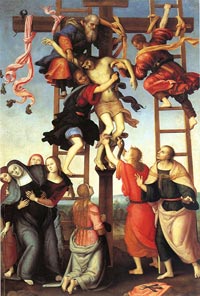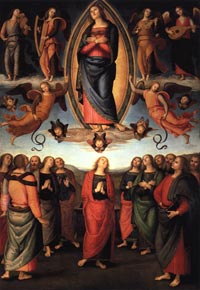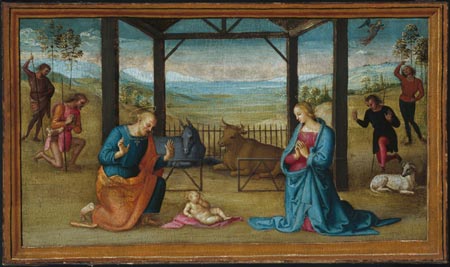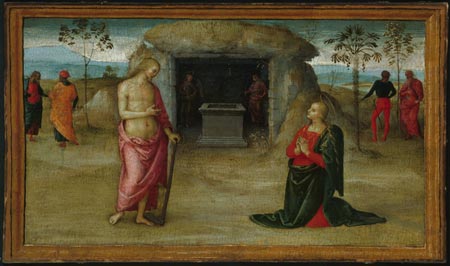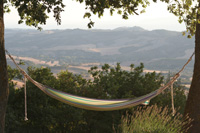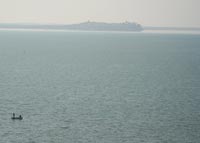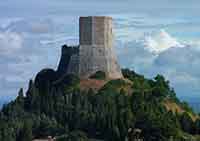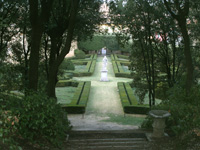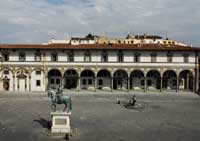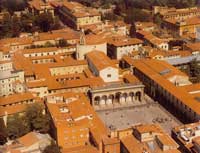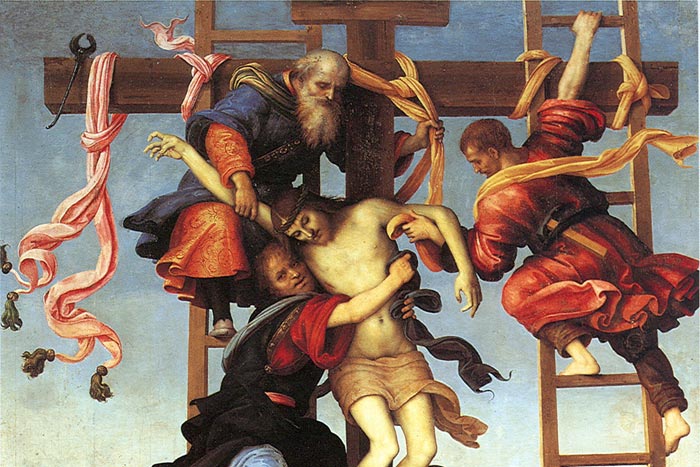 |
|||
Pietro Perugino and Filippino Lippi, Deposition of the Cross, 1503-1506, Florence, Galleria dell’Accademia |
|
||
Pietro Perugino | The Annunziata Polyptych |
| The Annunziata Polyptych is a painting cycle started by Filippino Lippi and finished by Pietro Perugino, whose central panel is now divided between the Galleria dell'Accademia (Deposition from the Cross) and the Basilica dell'Annunziata, both in Florence, Italy. The polyptych had other six panels, which are housed in the Lindenau-Museum of Altenburg, the Metropolitan Museum of New York, the Galleria Nazionale d'Arte Antica in Rome and in a private collection in South Africa. |
The work was originally commissioned to Filippino Lippi for the high altar of the Annunziata Basilica in Florence. Lippi had already ceded the same commission to Leonardo da Vinci, who had executed a cartoon with St. Anne, the Virgin and the Child, before abandoning the work when he followed Cesare Borgia (1502). The work was thus re-assigned to Lippi, who changed completely the theme. At his death in 1504 the painting, already completed in the central part, was assigned to Pietro Perugino, who completed it, including the secondary panels, in 1507.
|
||
Assumption of the Virgin (detail) |
||
According to Giorgio Vasari, Lippi executed the upper part of the painting. Jesus, left unfinished, was completed by Perugino in the face. The latter also painted the lower part of the work, characterized by his typical serene faces and the distant landscape. Perugino's assistants painted a great number of details, especially in the side panels.
It has been suggested that these five scenes may have formed the predella of the main altarpiece in the church of Santissima Annunziata in Florence [7]. This idea has now been largely rejected, and Christiansen has tentatively identified the predella with the altarpiece for the Chigi chapel in Sant'Agostino, Siena, commissioned in 1502. [7]
|
||
|
||
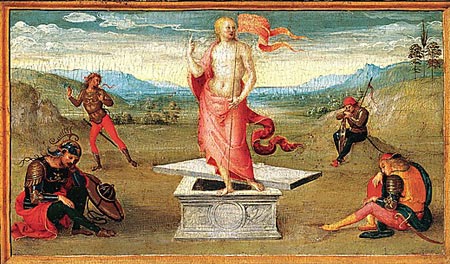 |
"This exceptionally well-preserved picture is one of five that probably formed a predella to an altarpiece of the Crucifixion painted in 1502 for the church of Sant'Agostino, Siena. The remaining four scenes are in the Art Institute of Chicago and show the "Nativity," the "Baptism of Christ," "Christ and the Woman of Samaria," and the "Noli me Tangere." They are executed with the loose brushwork and pale colors Perugino employed after about 1500. An attractive feature of the present picture is the feigned frame lit from the left." Along with four works in the Art Institute of Chicago, this panel formed the predella of an altarpiece. The Chicago pictures have been transferred from panel to canvas. They depict the Adoration of the Christ Child, the Baptism of Christ, Christ and the Woman of Samaria, and the Noli me Tangere. |
|
Resurrection of Christ, 27x45.7 cm, New York, Metropolitan Museum |
||
|
||
Nativity, 26.7x42.6 cm, Art Institute of Chicago |
||
|
||
Baptism of Christ, 26.7x42.6 cm, Art Institute of Chicago |
||
|
||
The Samaritan Girl at the Pit, 26,7x42.6 cm, Art Institute of Chicago |
||
|
||
Noli me tangere, 26.7x42.6 cm, Art Institute of Chicago |
||
|
||
|
||||
|
||||
|
|
||||
|
||||
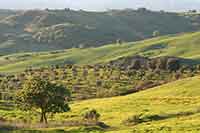 |
||||
Podere Santa Pia |
Podere Santa Pia, garden |
Century-old olive trees, between Podere Santa Pia and Cinigiano |
||
Lago Trasimeno |
Rocca d'Orcia |
San Quirico d'Orcia, Leonini Gardens |
||
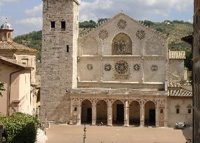 |
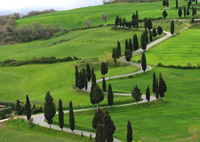 |
|||
Cortona |
Spoleto, Duomo |
Cipress road near Montichiello |
||
Even today the Maremma remains a largely undiscovered gem in the heart of Italy, sandwiched between the stunning Monte Amiata on its eastern fringes and the beautiful Tyrrhenian coast to the west.
|
||||
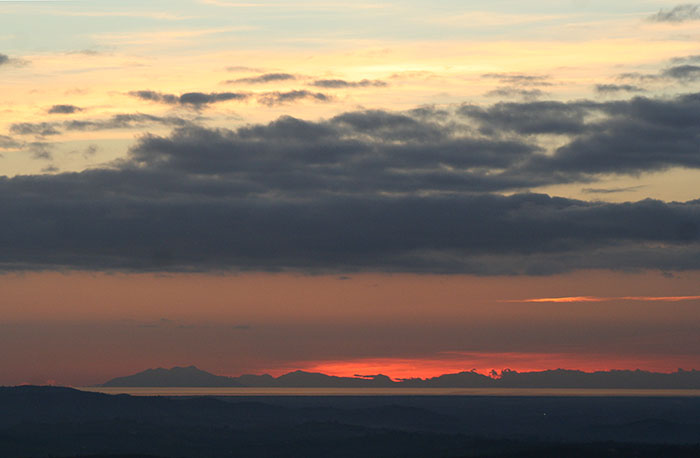 |
||||
Podere Santa Pia offers the most exclusive privacy to enjoy a breathtaking view and have a comfortable, regenerating holiday
|
||||
| The Piazza della Santissima Annunziata and Basilica dell'Annunziata |
||||
| One of the most beautiful piazzas in Florence, Piazza della Santissima Annunziata exemplifies the stylistic harmony of some of the greatest architects of the Renaissance. The church that gives the piazza its name, the Santissima Annunziata, lies behind the central portico of the piazza. The area of the piazza was chosen in 1250 as a space for a little church. At the time the piazza lay in open countryside outside the walls of Florence, in an area called Cafaggio. The church houses the Miraculous Annunciation, a masterpiece that according to legend was painted by an angel. The church became the destination of pilgrimages and processions and it soon became necessary to expand the church and the piazza, in addition to connecting it to the city center. The piazza is flanked by the Brunelleschi-designed and La Robbia-decorated façade of the Spedale degli Innocenti which was the first orphanage in Europe.The building is inspired by classical models that Brunelleschi studied in Rome. Under the loggia of the hospital, is still possible to observe the famous wheel where you could anonymously leave babies by placing them into a cavity that opened as the wheel turned. Ophans were called "Innocents", which is still how they are commonly called in Florence. The Spedale today houses a museum as well as some offices of UNICEF. Giambologna's last statue, of Ferdinando I de' Medici, was finished by his student Pietro Tacca and sits in the center of the piazza. Tacca also designed the two Baroque bronze fountains on the piazza. On the south side of the piazza lies the Palazzo Gattai Puddings, formerly Palazzo Grifoni, built in 1563-1574 by Bartolomeo Ammannati for the Secretary of Cosimo di Jacopo Ugolino Grifoni. Since November 2006, the ancient entrance to the National Archaeological Museum of Florence has been reopened in the piazza, after being closed due to major damage from the flood of Florence in 1966. The Basilica della Santissima Annunziata (Basilica of the Most Holy Annunciation) is a Roman Catholic minor basilica in Florence, Italy, the mother church of the Servite order. It is located at the northeastern side of the Piazza Santissima Annunziata. |
||||
| The Galleria dell'Accademia | ||||
The Galleria dell'Accademia Museum, hosting Michelangelo's and old Florentine masterpieces. Over time the Gallery has become one of the main museums in town, also thanks to the acquisition of some extraordinary masterpieces, such as the "Pieta" by Giovanni da Milano (14th century); the "Annunciation" by Lorenzo Monaco (15th century); the splendid frontal called "Cassone Adimari" showing a sumptuous marriage procession (c. 1450), the "Madonna of the Sea"attributed to Botticelli (1445-1510) and the Descent from the cross by Filippino Lippi and Pietro Perugino
|
||||
| This article incorporates material from the Wikipedia articles Pietro Perugino and Annunziata Polyptych published under the GNU Free Documentation License. Wikimedia Commons has media related to Pala dell'Annunziata. | ||||

